DS904: The Mars Free Ferry
David Noel
<davidn@aoi.com.au>
Ben Franklin Centre for Theoretical Research
PO Box 27, Subiaco, WA 6008, Australia.
Moving People and Things on longer journeys
If you need to travel from where you live to a conference in a distant country, your trip will usually be made up of a series of stages. You may need to take a taxi to a nearby train station, a train to an international airport, and a plane or planes to an airport close to where the conference will be held. From there you may need a series of stages to get to the actual conference venue.
If you want to move something from Earth to Mars, it is only commonsense to break the journey up, where possible, into a series of stages. This Mars Free Ferry article looks at the central, long-haul part of the journey, moving from the vicinity of Earth to the vicinity of Mars.
The Mars Free Ferry is a proposal to set up a series of ferries which remain permanently in what is called a Hohmann Orbit. This is an elliptical orbit which grazes each of the roughly circular orbits of Earth and Mars.
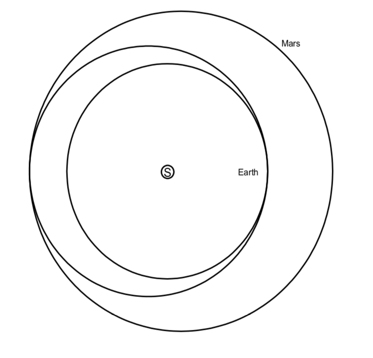
Fig. DS904-F1. The Hohmann transfer orbit between Earth and Mars perihelion.. From [2].
Mechanics of the MFF
Following is a summary from an earlier project [1].
The basis of the Mars Free Ferry is an essentially unpowered space object moving continuously between the orbits of Earth and Mars. This might well be on an elliptical Hohmann Transfer Orbit.
Say you're an interplanetary trader, you have a container of widgets which you need delivering to Mars. You hire a space taxi to get the container up to Earth orbit (actually likely to involve several stages), and have the taxi match the orbit of the closest (in delta-V) of the 12 Mars Free Ferries, say the December one.
Once there, you wire the container onto one of the shackle points of the MFF, and go home. Later, on Mars, your agent takes their space taxi up to the approaching MFF, unhooks and stows the container, and descends to the Mars Customs base. The MFF continues on its way.
In this summary, "delta-V" is a representation of the energy needed to transfer something from one place in space to another. (In [5] it says "Delta-v, literally "change in velocity", symbolised as Δv and pronounced delta-vee, as used in spacecraft flight dynamics, is a measure of the impulse that is needed to perform a manoeuvre such as launch from, or landing on a planet or moon, or in-space orbital manoeuvre. It is a scalar that has the units of speed.)
The minimum delta-V needed to move something between two points in space, say to move a wheelbarrow from a warehouse on Earth to a warehouse on Mars, is fixed and depends on the mass of the wheelbarrow and the relative positions and directions of motion of the two points on Mars and Earth. Space engineers are very concerned with delta-V, looking at it in terms of its equivalence in rocket fuel.
The logic of the MFF approach
The whole purpose of the Mars Free Ferry approach is get efficient interplanetary transfer. An object travelling in a MFF does not use any delta-v, any fuel, at all for the central, interplanetary leg. However there is no magic as regards the delta-v for the whole transfer -- fuel must still be used to get an item up to the MFF orbit and match the MFF's velocity vector, and at the Mars end, to pick the item off the MFF and get it down to Mars' surface.
Where the MFF saves is not spending delta-v to move the same stuff again and again each time for a series of transfers. If you plan a manned expedition to Mars in a rocket ship, you have to provide safe living quarters, amenities, and cargo holds for everything you take. With MFF, most of the hardware and equipment is used again and again, you only need provide the consumables needed in the particular instance.
Think back to the earlier example of travelling to a distant conference, with the central leg by air. At any time in the present, there are said to be a million passengers in the air, many of whom will be eating one or more meals during their flight.
Of course these meals are not cooked from scratch in an on-board kitchen on each airliner, instead they are prepared on the ground and just heated up as needed on each flight. It would be totally uneconomic, totally inefficient, to have a full kitchen and chefs on board each airplane. The plane carries only the consumables needed.
Similarly, for a particular MFF transfer, the aim would to move only the items needing transfer and any consumables needed. If the MFF happened to be carrying only goods, there would no need to use life-support facilities which might be present. If people were to be transported, they could use a living module permanently part of the MFF, a "Hohmann Hotel," rather than carrying their hotel with them anew on each journey.
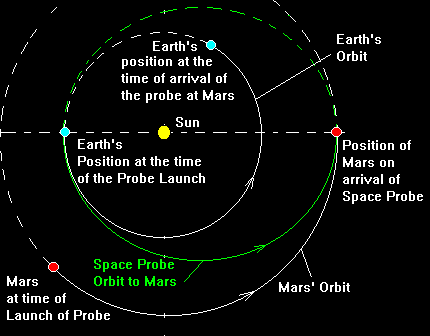
Fig. DS904-F2. The Hohmann transfer orbit between Earth and Mars. From [3].
The diagram shows how a conventional spaceship might be sent to Mars, using a Hohmann orbit. The transfer orbit has to be timed so that when the spacecraft departs Earth, it will arrive at the outermost point of its elliptical orbit just as Mars reaches the same position in its own orbit. Earth and Mars align properly for a such a Hohmann transfer once every 26 months.
Operating a MFF
As a assemblage moving permanently in space, outside any atmosphere, an MFF would not need to have any particular shape or cladding such as heat shields. Here is more from [1].
The MFFs are permanently in a space environment, and might resemble maybe a wired-together junkyard. In the yard there may, or may not, be one or more living modules, which will need to be supplied with life-support stuff like oxygen and food, and have working equipment such as toilets and kitchens. Maybe the whole mess is spinning to provide artificial gravity. Maybe a radiation refuge.
Obviously the MFF does not use any energy to continue in its elliptical orbit. If it has living modules, these will need life-support consumables, but not life-support equipment -- that is already there. Essentially, the only delta-V you need for Earth-to-Mars or back is taken up by moving cargo or people between the planet surfaces and the MFF orbit. In the MFF orbit, no delta-V is needed, all the components of the ferry assemblage travel for free.
That said, the MFF will have minor costs for communications, maintenance, and possibly minor course correction for second-order perturbations to its orbit, but these will be only minor.
Much of the transfer operations might be handled by robot or drone equipment -- maybe the space taxis might be unmanned for freight transfer.
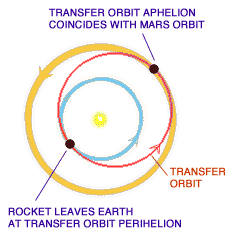
Fig. DS904-F3. The Hohmann transfer orbit between Earth and Mars. From [6].
How long would an MFF transfer take?
According to [6], the trip from Earth orbit to Mars orbit would take around seven months -- a bit longer than astronauts currently stay on the International Space Station. The precise duration of each journey depends on when it is taken. Because both Mars and Earth's orbits are not perfectly circular, the time it takes to travel between them varies from six to eight months.
It should be mentioned that while the MFF approach is expected to be the most convenient and effective way of establishing regular interchange of goods, materials, and people between Earth and Mars, it may not be the minimum-delta-v solution sought by engineers. In general a Hohmann transfer orbit would use the lowest possible amount of energy in travelling between the two planets [4].
Way-Stations in orbit around Earth and Mars
Using the usual multi-stage approach, it would be normal to have way-stations in orbit around Earth and Mars, which would warehouse goods or act as departure or arrival lounges for the next MFF transfer. There are a number of possibilities for these.
As well as near-Earth orbits for the way-stations, another possibility is to use what are called Lagrange Points. These are special positions relative to Earth (and Mars) which turn out to gravitationally stable.
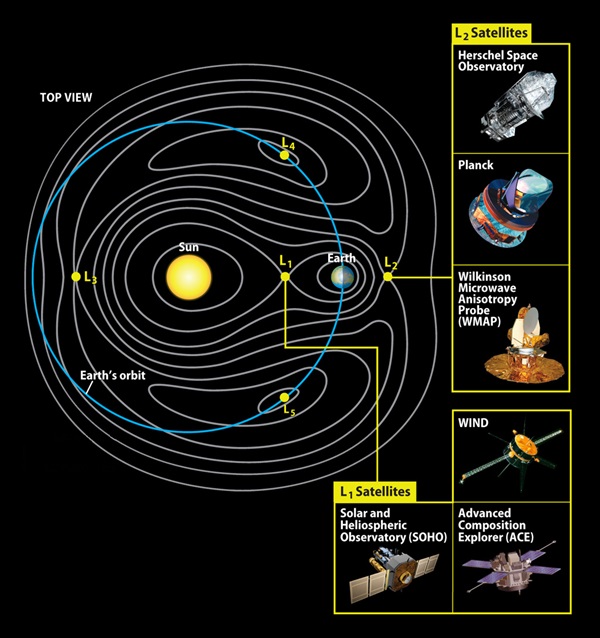
Fig. DS904-F4. Earth's Lagrange Points (not to scale). From [10].
The diagram shows the five Lagrange Points for Earth, marked L1 to L5, as low points or dips in the lines of gravitational influence. At present scientists have a number of observatory satellites parked at the L1 and L2 points, such as the WMAP, the Wilkinson Microwave Anisotropy Probe, at L2. The L2 point will also be the place where the currently being built James Webb Space Telescope will be situated.

Fig. DS904-F5. The James Webb Space Telescope relative to the Hubble telescope's orbit around the Earth. From [11].
The James Webb Space Telescope is the successor to the Hubble Space Telescope, which is in near-Earth orbit, only 570 km above the surface. By contrast, the JWST will be about 1.5 million km away, well beyond the Moon. It is expected to launch in 2019.
The Lagrange Points may turn out to be good for the MFF way-stations. According to Brian Dodson [2], one particularly effective approach is to place the way-station for Earth at the Sun-Earth Lagrange point 1 or 2, and the Mars way-station at the Sun-Mars Lagrange point 1 or 2. The L1 and L2 points have an orbital period equal to that of the associated planet, so an object placed there will remain at that point relative to the planet.
How many MFFs will operate?
A single MFF will be of varying usefulness according to how well it matches the current positions of Earth and Mars. Looking back at Figure F2, this shows the positioning for a space probe launched from Earth on a Hohmann orbit to meet up with Mars about 7 months later.
By setting up several MFFs touching Earth's orbit at different times of the year, it will be possible to choose the right MFF to get a good match for transfer to a Mars way-station. Mars takes about two Earth years to complete its orbit, so having three MFFs with perihelions (Earth-orbit touching points) four months apart would allow Earth-Mars transfers no more than four months from optimum.
As the transfer of stuff built up, it would be possible to have 6 MFFs leaving 2-months apart, or 12 MFFs, one leaving Earth every month. To service an MFF, a space taxi should not need to coast along a planetary orbit for more than about 14 days, in order to meet the closest way-station. The delta-V needed, for the space taxi to slow down slightly or speed up slightly to achieve a match, is not great.
In the end, the final setup will be the usual commercial compromise between minimum cost and maximum convenience. Even with a well-functioning MFF setup, there is no reason why an urgent delivery or extraction from planet, way-station, or MFF should not be achieved, provided that the user was prepared to expend the necessary delta-V.
Elon Musk's Roadster and Starman
The February 2018 launch of SpaceX's Falcon Heavy rocket launch might have incidentally formed the nucleus for the first Mars Free Ferry assembly. As a sample payload for this launch, the Falcon Heavy carried Elon Musk's own roadster and a suited dummy called Starman. There is a very nice YouTube video about this operation at [9].
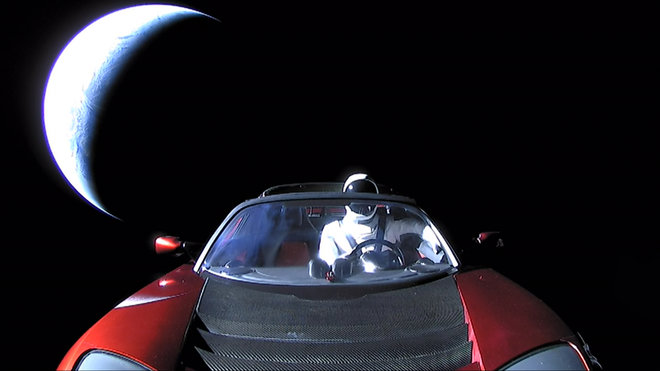
Fig. DS904-F6. Elon Musk's Tesla Roadster and Starman cruise away from Earth in this final photo from the car after its launch on SpaceX's first Falcon Heavy rocket on Feb. 6, 2018. From [8].
The picture above is an actual photograph taken from the front of the roadster, showing the crescent Earth retreating in the background behind the car. The interesting thing about the orbit planned for Starman and the roadster is that it should have been a Hohmann orbit, which would have allowed the payload to have formed the nucleus for the first MFF.
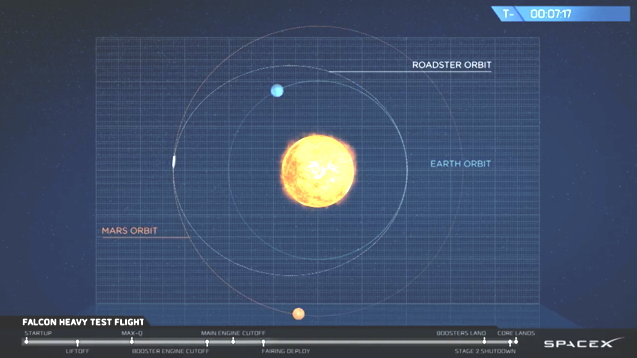
Fig. DS904-F7. Planned orbit for the SpaceX Roadster. From [7].
This is shown in SpaceX's own video coverage of the flight [7], which in general was very successful. Starman and the Roadster did not achieve an exact Hohmann orbit, but are expected to continue to orbit between Earth and Mars for perhaps millions of years. Their orbit could be corrected in the future, leaving them parked at one end of an MFF assembly yard, as a permanent record of work on the Mars Free Ferry!
* * * * * * * * * * * * * * * * * *

References and Links
[1]. Wanted, orbit calculations for a permanent Earth-Mars interplanetary shuttle. http://zombal.com/zomb/scientific-calculation/wanted-orbit-calculations-for-a-permanent-earth-mars-interplanetary-shuttle/ .
[2]. Brian Dodson. Earth-Mars Interplanetary Transport System. http://assets.zombal.com/82b52a5c/MFF%20Final%20Earth%20ExNeoOffice.pdf .
[3]. Hohmann transfer orbit diagram. http://www.planetary.org/multimedia/space-images/charts/hohmann-transfer-orbit.html .
[4]. Hohmann transfer orbit. https://en.wikipedia.org/wiki/Hohmann_transfer_orbit .
[5]. Delta-v. https://en.wikipedia.org/wiki/Delta-v .
[6]. How long does it take to travel to Mars?. https://www.mars-one.com/faq/mission-to-mars/how-long-does-it-take-to-travel-to-mars .
[7]. Falcon Heavy Test Flight. https://www.youtube.com/watch?v=wbSwFU6tY1c .
[8]. Elon Musk's Tesla Roadster and Starman Leave Earth Forever in This Final Photo. https://www.livescience.com/61706-spacex-tesla-roadster-starman-final-photo.html .
[9]. Falcon Heavy Animation. https://www.youtube.com/watch?v=Tk338VXcb24 .
[10]. Dave Aiken. How big are the Lagrangian points?. http://www.astronomy.com/magazine/ask-astro/2013/10/lagrangian-points .
[11]. L2 Will be the James Webb Space Telescope's Home in Space. https://www.nasa.gov/topics/universe/features/webb-l2.html .
Go to the Devices Home Page
Version 1.0 compilation started 2018 Feb 5, on Web 2018 Mar 5.









